 Let’s check the Gogglebob.com mail bag! MetManMas writes, saying…
Let’s check the Gogglebob.com mail bag! MetManMas writes, saying…
“Amagon has some great aesthetics for its age…which makes it all the more disappointing that it’s a game with such a cruel, hateful difficulty level made by people who just couldn’t get out of that quarter munching mindset.”
That’s a great point, MetManMas! And it gets me thinking…
The general crux of my Amagon article was that this game is bad (bad bad bad), and comparing it to games that are merely mediocre is a mistake. This, unfortunately, is not how many people examining retro games work, as hyperbole is the order of the day, and ranting and raving against the horrors of “terrible” games that “raped childhoods” is what gets the hits. Again, I want to be clear that I’m not saying that the angry video game nerds of the world are bad or wrong or anything, simply that that kind of thinking has a tendency to subconsciously place everything into either “holy” or “horrible” tiers, and the genuinely bad (or genuinely good) games are swept into the same all-encompassing echelon. In short, I don’t want to live in a world where Amagon and Mega Man are mentioned in the same breath.
But… that’s not me. No, I don’t mean the hyperbole isn’t me (though I am easily the least hyperbolic person in this or any other galaxy), I mean that simply ridiculing a position or thought for the sake of deriding it is something I try to avoid doing. Maybe Amagon just put me in a foul mood, but I try my best to understand why something is happening rather than merely saying, “No, don’t do that.” I’m not always right, and sometimes it leads to utter madness (I’ve been trying to understand Trump supporters all year, and I just keep waking up naked and covered in bubble bath), but I truly believe that we should do our best to understand each other. I believe that 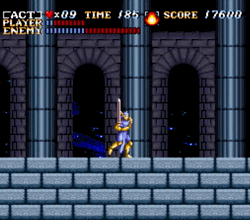 people hyperbolically insulting (or praising) games indiscriminately are bad for the health of games journalism, but why do people do it?
people hyperbolically insulting (or praising) games indiscriminately are bad for the health of games journalism, but why do people do it?
Okay, yes, obviously the first answer is that it’s entertaining. It’s a lot easier to watch and enjoy someone shouting at a game’s imagined slights against a gamer’s mother than it is to sit through a lengthy lecture on jumping physics. Clicks are king, and, yes, screeching complaints are likely to gain some notoriety. Even in the world of words, some writers like Seanbaby (arguably the guy that started this trend) are practically deities of this craft. Unfortunately, a lot of people ignore the fact that what really works there is not the bile at the worst NES games in the world, it’s the perfectly smooth similes that are like… some… kind of bird… that is good at flying? A flying good bird? Something like that. Regardless, there are some great, inordinately entertaining hyperbolic gamers out there, but there are also a number of Bubsies out there, too, seemingly doing it for the money/fame/cons/attention/groupies. It’s niche trendy, and who doesn’t like to see that youtube hit counter tick up?
But let’s look deeper than that. Let’s consider why we get mad at video games. I talk about this phenomena like I’m completely immune, but look no further than these articles on Primal Rage and Fester’s Quest for full “Goggle Bob thinks this is the worst thing in the world” narratives. And with both of those games, I know the reason those articles are dripping with venom: those games suck! Wait, no, what I mean to say is: those are games that, when I played them as a child, were complete disappointments. I like fighting games! I like dinosaurs! I generally tolerate bald guys with blunderbusses! Yet these games sucked, and they 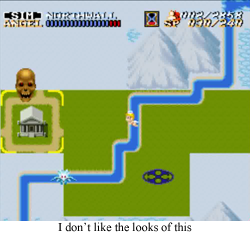 sucked so hard that, years later, all I can think about is how much I hate them. I HATE THEM WITH THE FURY OF AT LEAST TWO FURIES!
sucked so hard that, years later, all I can think about is how much I hate them. I HATE THEM WITH THE FURY OF AT LEAST TWO FURIES!
… Hm, I can see how it’s easy to slip into that…
And, yes, this all has something to do with game du jour. ActRaiser is a pretty interesting game all on its own, but it is particularly notable as (practically) a SNES launch game. ActRaiser is the story of “The Master”, who is basically a god, if not THE God. Master has been slacking off, though, and Tanzra took over the world, separated the land amongst his six lieutenants (as 16-bit villains do), and generally screwed with what few people remained over the course of a few centuries. But Master’s mandi/pedi is finally over, and he’s back to kick ass and take names. Seriously, he really wants the name of that wizard that is also a werewolf. Werewiz? Wolfzard? So many options.
Now, this may sound like the basic plot to about 7,000 8/16-bit action games. Sure, you’re a deity, but that has never meant anything, just ask Superman and his meager videogame hit points. But, no, there’s a lot more to this game than you’d expect from the initial description. For one thing, yes, there 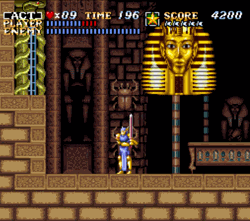 are action sequences where you’re running around with a sword slaying regular-sized manticores, but the most memorable bits of ActRaiser occur during the “Sim” portions that prove whether or not you have what it takes to be a god.
are action sequences where you’re running around with a sword slaying regular-sized manticores, but the most memorable bits of ActRaiser occur during the “Sim” portions that prove whether or not you have what it takes to be a god.
Every Actraiser level begins and ends with an action sequence, but between those, you’ll find ActRaiser’s time to shine (literally). You’re god, and people are weak and helpless, so it’s your job to navigate a chubby little angel helper in pursuit of making the world a better place. Monsters are attacking! Well, arrow down those monsters, and direct the people to monster lairs so that the threat may be permanently sealed. Rocks in the way? Call down the thunder and clear those fields. Entire place covered in snow? Here comes the sun! In short, it’s one part SimCity, one part Zelda, and one part, I don’t know, Pac-Man 2 (… okay, I may have earthquaked an entire settlement just to see what would happen). This is all the more impressive when you consider that this game was released in 1991 (1990 in Japan), well before many franchises mastered proper jumping physics. ActRaiser was brilliantly ahead of its time, and those Sim sections are still entertaining and novel today.
Except… when I played this game back during the dawn of the 16-bit age… I barely got past the first level.
ActRaiser’s action sections aren’t impossible (and, in fact, they were tuned down after the Japanese release), but they’re still pretty unforgiving. Bottomless pits and swiftly moving platforms may account for a number of lost lives. Monsters boasting attack patterns that seem 100% designed to hit you anywhere on the screen are going to drain your health pretty fast. And the greatest impediment to progress is Master’s own sword, which makes the length of Adventure of Link’s blade look positively dhalsimian by comparison. Until you obtain magic (which is very limited), 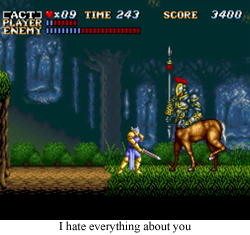 Master is stuck with few offensive options, and, save a temporary sword powerup that I found once in the entire game, it seems like Master is insufficiently equipped for his missions.
Master is stuck with few offensive options, and, save a temporary sword powerup that I found once in the entire game, it seems like Master is insufficiently equipped for his missions.
And it makes me angry!
Actraiser is a delightful game when it isn’t slamming your face into the concrete. I’ve already recounted the joys of the Sim sections, but the action sections are interesting and varied on their own. The graphics are great, and they actually serve the purpose of making each area distinct. In an era (that persists) when every game was just grass, sewer, lava, ice, and finally techno world, ActRaiser made every stage feel like its own area. You’d never mistake the craggy volcano of Aitos for the tropical temple of Marahna. Yes, a number of these areas seem to fit those tired old tropes (oh, look, an ice stage), but they go in fascinating directions (an ice stage… where you’re climbing an ancient tree by riding bubbles to fight a crystalline dragon). There’s a lot of creativity on display here, and, once you’re 100% familiar with the controls and your own limitations, the levels are tough, but fair.
But you’ll never see even a tenth of it if you don’t finish the first boss. And, save function or no, you’re probably not going to see the end if it takes hours and hours to escape the second level.
And I want to say this is why so many gamers are angry. There’s a great game here, and, after only intending to give this experience an hour or so, I played through the whole game, start to finish, in 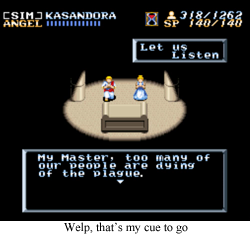 one afternoon. I was riveted! I loved playing ActRaiser! I also cheated myself into infinite lives, and, for a few areas, infinite health. And, oh yeah, I have thirty years of action/platforming experience.
one afternoon. I was riveted! I loved playing ActRaiser! I also cheated myself into infinite lives, and, for a few areas, infinite health. And, oh yeah, I have thirty years of action/platforming experience.
Back when I didn’t have that experience (or a Game Genie) I rented ActRaiser… and I never saw past Fillmore. There was an entire game here, an entire phenomenal game, and I didn’t get to play it, because I couldn’t conquer the initial challenges. I spent years thinking ActRaiser wasn’t any good, years I spent playing Final Fight over and over again, when there was another great game on that system… just locked away behind seemingly insurmountable challenges.
And when I think about that, well, I get a little angry.
FGC #140 ActRaiser
- System: Super Nintendo. According to the data I have here, it somehow has not seen a Virtual Console rerelease, but it was available in a limited form for cell phones? That can’t be good.
- Number of players: Monotheistic.
- Absolute Power: You level up in the Sim portions according to how many villagers are alive and worshipping you. Technically, after you clear a level up stratum, you can’t be demoted for the population taking a hit… so that would be the appropriate time to test the relationship between thundershowers and followers.
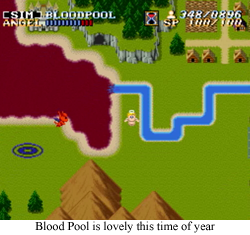 What’s that burning smell?
What’s that burning smell? - Homogenization: When the game begins, each “land” appears to be very distinct. By the time your quest is completed, you’ve melted all the ice, revitalized the dessert, and bulldozed all those pesky palm trees. You even drained the blood lake! And now every area looks exactly like every other area! Ugh, this neighborhood used to be so cool…
- Favorite Boss: The Arctic Wyvern is just the coolest thing to look at. I seem to remember like every Nintendo Power preview/review of Actraiser included that dang dragon. Dagoba gets honorable mention for starting the trend of antlion bosses on the SNES.
- An end: The ending posits that when the world is safe and the people are content, they don’t really need a god to worship. This is an excellent moral that is only contradicted by all of human history.
- Did you know? The original Japanese version makes the subtext regular text: you are “God”, and the villain is Satan. While I normally disparage Nintendo of America censoring religious items in SNES games, I kind of support this one, as I could actually see some outrage spewing from a game that is predicated on the concept that “God” could be defeated for centuries, and then spends all his time battling minotaurs. God is supposed to be more… beard based!
- Would I play again? Yeah, probably. Just, ya know, still going to cheat a little.
What’s next? Random ROB has chosen… Sqoon for the NES…? What? Uh, yeah, that’s not a word in any way. I think my robot is broken. I guess look forward to… Sqoon.
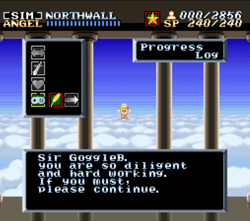

Actually, ActRaiser was ported to Virtual Console, at least on the original Wii. In fact, it’s one of the few games from the Enix side of the Square Enix pond to see a VC release.
Sadly, Enix’s pre-merger role as more of a producer than a developer seems to have killed the chances of its quirky mixed bag of Super Nintendo and Super Famicom content ever seeing rereleases.
[…] be considered “the world” was bubbled into a collection of artifacts that maybe some intrepid ActRaiser would revisit later. And you are that raiser of acts! Put the world back together as you see […]